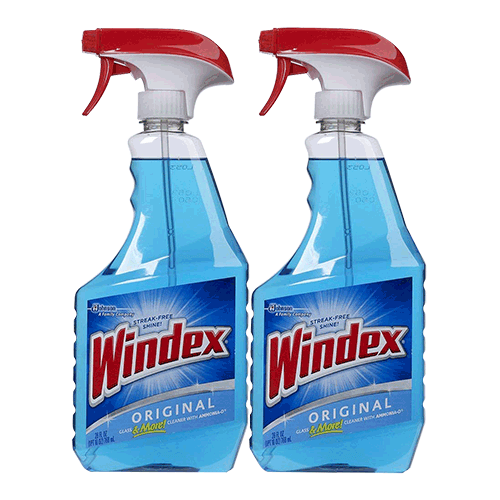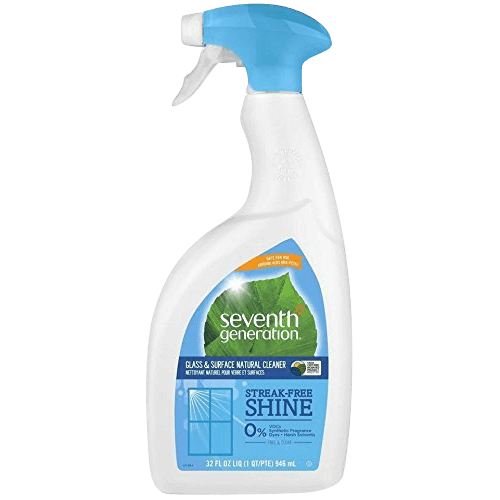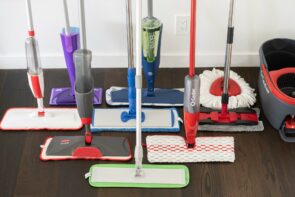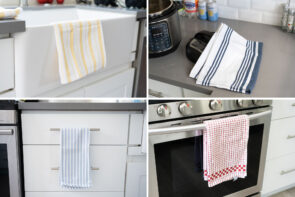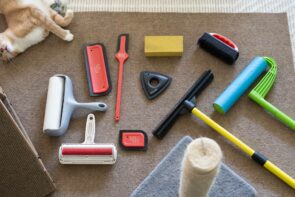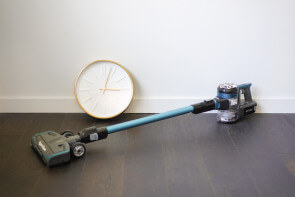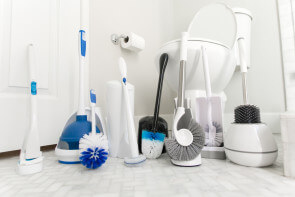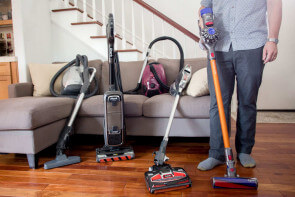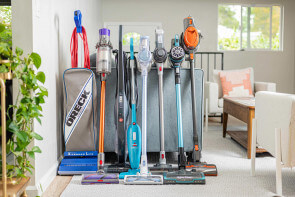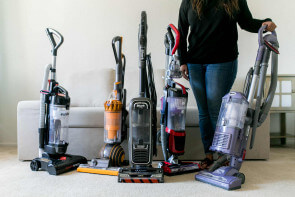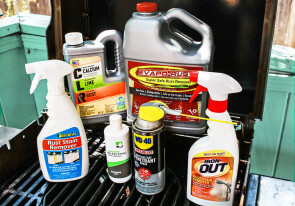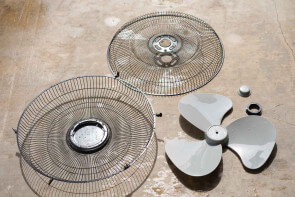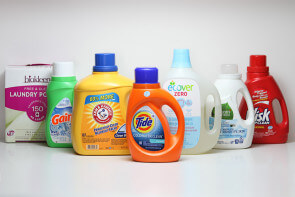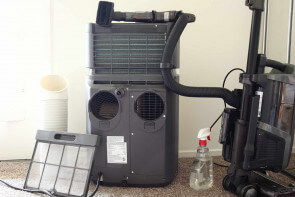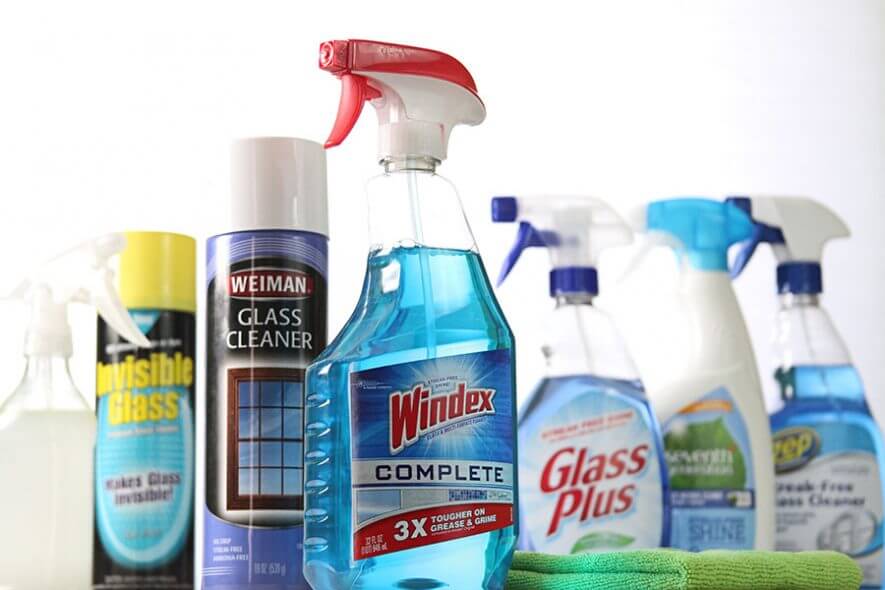
The Best Window Cleaners
After nearly 40 hours of reading, researching, spraying and wiping, we determined that Windex is the best window cleaner available. It’s powerful enough to break up grease and food stains on a variety of surfaces without leaving behind spots or streaks. Windex outperformed seven other glass cleaners by consistently eliminating blemishes and impurities and producing crystal-clear views and reflections. For a glass cleaner that attacks grease — like on your microwave — Weiman proved a star performer.
After nearly 40 hours of reading, researching, spraying and wiping, we determined that Windex is the best window cleaner available. It’s powerful enough to break up grease and food stains on a variety of surfaces without leaving behind spots or streaks. Windex outperformed seven other glass cleaners by consistently eliminating blemishes and impurities and producing crystal-clear views and reflections. For a glass cleaner that attacks grease — like on your microwave — Weiman proved a star performer.
Table of contents
- The 7 glass cleaners we tested
- Best overall: Windex – Complete
- Best for grease: Weiman – Glass Cleaner
- Best natural window cleaner
- How we selected
- How we tested
- The best way to clean glass
- How to make DIY window cleaner
- Important features to consider
- Other products we tested
- The bottom line
The 7 glass cleaners we tested
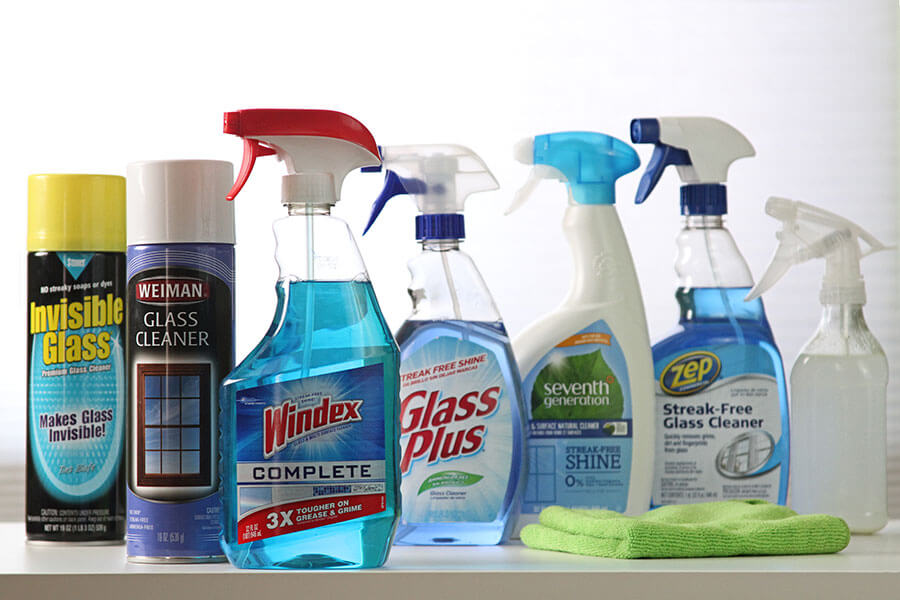
- Windex – Original
- Glass Plus – Glass Cleaner Trigger
- Weiman – Glass Cleaner
- Seventh Generation – Free & Clear Glass & Surface Cleaner
- Zep – Streak-Free Glass Cleaner
- Stoner – Invisible Glass Premium
- Your Best Digs – Homemade Glass Cleaner
Top Pick: Windex – Complete
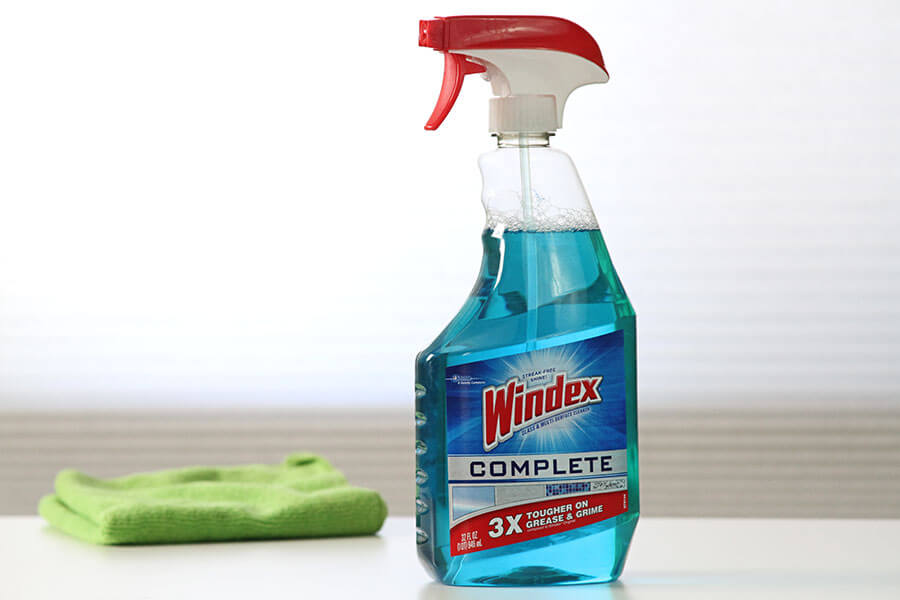
Our pick for best overall glass cleaner is Windex. It simply cleans and eliminates streaking better than any of the other products we tested. Windex proved to be up to even the most difficult challenges. The ammonia-based cleaner broke up difficult compounds and consistently removed dirty, sticky, greasy blemishes on mirrors, windows, and other surfaces.
While the scent of ammonia is powerful and unpleasant, it doesn’t linger in the air or on the cleaned surface. Just a few minutes after use, there’s no detectable fragrance.
It’s not just the smell that disappears quickly; it’s the ammonia. Because ammonia evaporates quicker than water, there is very little health risk shortly after cleaning. Only large amounts of high-concentrate ammonia can be dangerous if inhaled.
Finally, Windex is incredibly versatile. It took care of our messy, chili-covered microwave with only a bit of effort. The ammonia-based product is also great for tackling soap scum on bathroom fixtures and stains on tiled floors, polishing up old jewelry and even repelling insects.
For the dirtiest jobs on the widest variety of surfaces, Windex is the best product available.
Key takeaways:
- Windex is a powerful cleaning agent, capable of cleaning up the most stubborn stains and substances.
- As an ammonia-based cleaner, it is versatile and effective on many surfaces — not just glass.
- It reliably eliminates streaks, consistently leaving clear, beautiful glass.
Best for grease: Weiman – Glass Cleaner
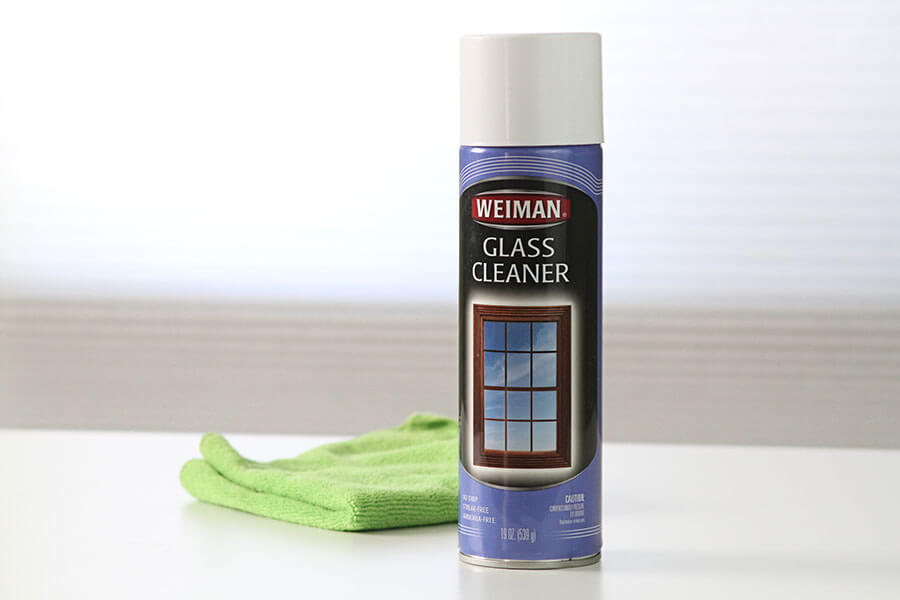
Weiman Glass Cleaner, with its penetrating foaming action, is the best at tackling the worst messes all over the house. It also has a less abrasive scent than the Stoner Invisible Glass aerosol can.
Weiman Glass cleaner did an exceptional job cleaning up our microwave chili explosion. The microwave looked as good as new with just one application of the foaming spray and a bit of easy wiping.
Key takeaways:
- Weiman Glass Cleaner is a strong cleansing foam that attacks grease, fats and other messes.
- This product makes it easy to clean up even the most stubborn stains and spots.
Best natural window cleaner
If you’re concerned about the potential impact of chemical-based cleaners on the environment and your health, you can make your own glass cleaner at home, following our recipe. Combining white vinegar, cornstarch, warm water, and essential oil creates a fantastic all-purpose cleaner that is effective on glass.
Our homemade product successfully cleaned messes off windows, mirrors, and other surfaces. While windows and mirrors may be left with faint signs of streaking, the long-lasting, refreshing scent of your favorite essential oil — and the incredible low price of making the mixture — more than make up for the flaw.
Key takeaways:
- The Your Best Digs homemade glass cleaner is an all-natural, biodegradable, digestible, non-toxic, all-purpose cleaning solution.
- You pick the fragrance, which will linger in the air hours after use.
Other products we tested
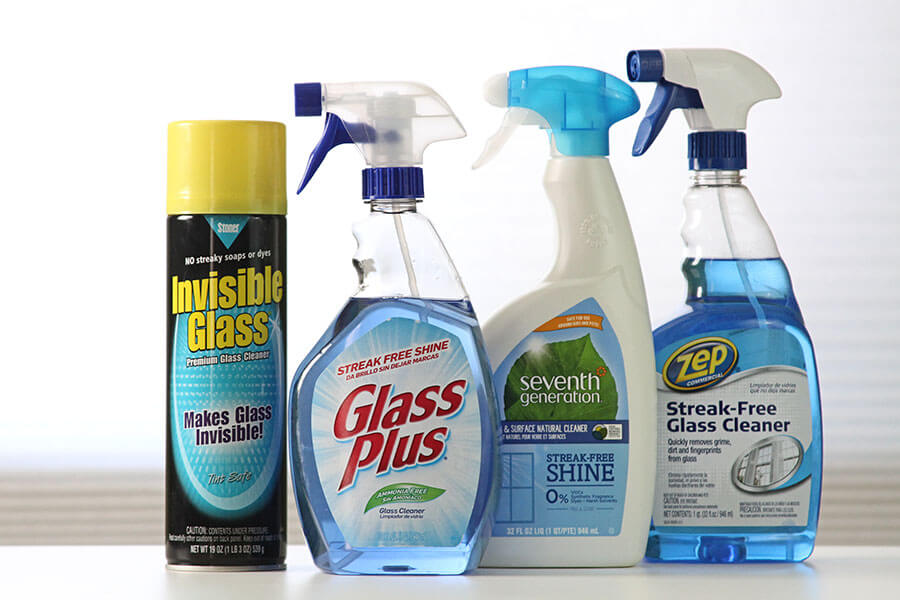
The other finalists we tested all were capable of clearing surfaces of grease and grime. Where they mostly fell short was failing to eliminate streaks.
Seventh Generation Free & Clear is a great product. Its plant-based cleaning agents are strong on messes, and it’s safe for the environment and your health.
Stoner Invisible Glass Premium Glass Cleaner proved very versatile, performing well at cutting through food spills in our microwave test. But like Glass Plus, it could not completely keep away streaks.
Zep Streak-Free Glass Cleaner did a better job cleaning without leaving streaks, but the odor was too unpleasant. The strong scent of ammonia takes away from an otherwise very effective product.
How we selected
We started by reading user reviews, marketing materials, consumer reports, and homecare blogs. Then, we dove into the science and debate about chemicals, exposure, safety, and do-it-yourself alternatives.
We looked at subreddits, like /r/homemaking, /r/diy, and even /r/autodetailing to find out what consumers think about the best glass cleaners on the market. With this information, we whittled our field down to six brands that represented the different methods of cleaning glass.
We opted to try one homemade recipe, one plant-based product, two cleaners containing ammonia, two aerosol sprays and one of the most well-known window-cleaning brands. We tested these products for their ability to eliminate dirt and germs on a variety of glass and other surfaces while leaving a streak-free finish.
How we tested
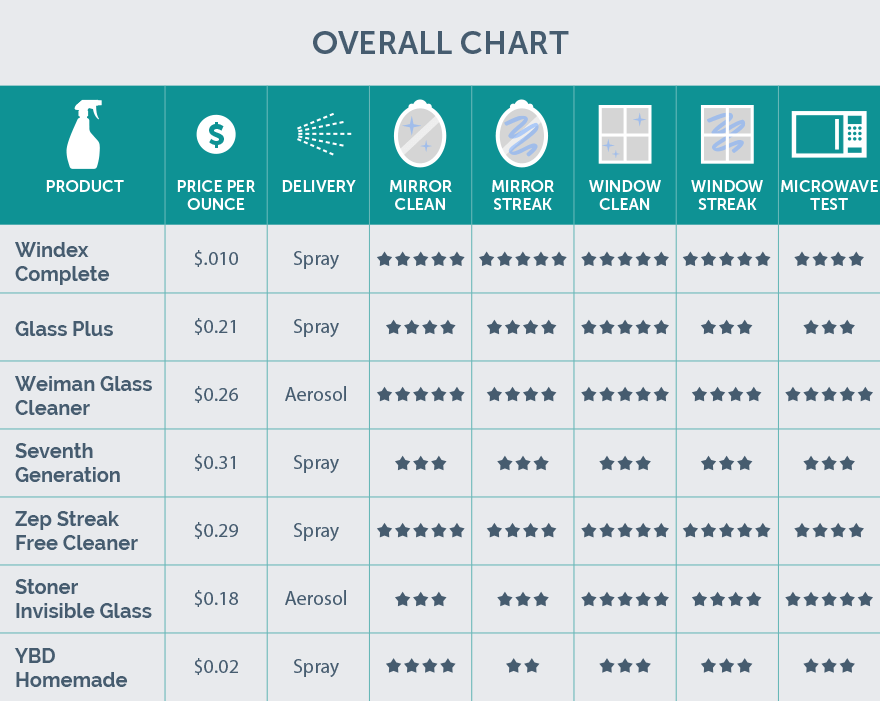
Cost
In order to fairly compare the prices of our products, we calculated their price per ounce based on popular packaging sold on Amazon at the time of publishing.
To calculate the cost of our DIY glass cleaner, we also combined the costs of the ingredients we used, which were purchased at local grocery stores. We then calculated the cost based on the portion of the product we used for our mixture.
Our simple, homemade Your Best Digs cleaner is by far the cheapest way (per ounce) to clean glass surfaces although it is more costly, both in time and money, upfront.
Windex is the least expensive commercial product, but it should be noted that buying large refill containers, like the 128-ounce Windex offering on Amazon.com, typically lowers the price regardless of the brand. Seventh Generation is the most expensive because of its plant-based ingredients.
Windows

Windows must be cleaned from both the inside and the outside. We simulated cleaning the outside of a living room window by smearing mud and dirt on it and letting it set. Then, we pressed an olive oil-coated hand against the window and smeared it around to mimic greasy palm prints. After five minutes, we used each product to tackle the job of cleaning the window.
In terms of both removing the substances and leaving a streak-free finish, the products from Windex and Zep Streak-Free Glass Cleaner distinguished themselves as superior to the others. Both glass cleaners clung to the window without running, which helped them penetrate the more difficult stains. The complete absence of streaks or fog left the windows stunningly clear.
The two aerosol products, Weiman Glass Cleaner and Stoner Invisible Glass Cleaner, proved to be powerful as well. The foaming spray loosened up even the toughest parts of the mess, allowing it to be easily wiped away. However, they also left the windows just a bit streaky. The streaks were not distracting or even all that obvious, but they were noticeable from certain angles. The Glass Plus Glass Cleaner Trigger also cleaned well but left even more noticeable streaking.
Seventh Generation Surface Cleaner and our DIY cleaner had more difficulty eliminating signs of the mess — especially the oily handprints. While the prints themselves were removed, residue from the oil remained on the window and left visible streaks. Even after prolonged buffing, the windows weren’t as clean as they were when we tested Windex and Zep.
Mirrors
If windows account for the largest surface area of glass in the house, mirrors are probably second. And although this is technically a review of window cleaners, you may apply the cleaner in other contexts. Bathroom mirrors in particular put up with a lot of abuse. Sprays, gels, creams, lotions, and fingerprints smudge mirrors on a daily basis.
To simulate these real-world cleaning situations, we applied a dime-sized amount of toothpaste to a fingertip and smeared it across the bathroom mirror. We then did the same with a dime-sized drop of hair gel. We let the smudge marks set for 15 minutes and then used our glass-cleaning method to tackle the task.
Many of the products easily removed the stains, but Windex did so with only moderate pressure being applied and it required very little buffing to completely eliminate streaks. The mirror simply looked the best after it had been cleaned with the Windex solution.
Glass Plus was effective, but we needed to apply more effort and pressure to scrub away the toothpaste. There were also slight streaks left on the surface.
The products from Weiman Glass Cleaner and Zep Streak-Free Glass Cleaner left behind faint streaks that were detectable depending on our angle and distance from the glass.
Our homemade solution easily removed the blemishes but left the mirror looking cloudy and a bit dull. It was a noticeable difference compared to the commercially available options.
Seventh Generation took care of the problem substances just fine but failed to remove lingering specks of dust. Even prolonged buffing could not eliminate these tiny but visible imperfections.
The Stoner cleaner worked on the hair gel quickly but required additional applications to fully scrub off the toothpaste. The instructions on the can state that second and third applications may be needed to loosen and absorb trace deposits. But even after the third application we still observed a bit of residue.
Exploding chili in the microwave

Having put our finalists through a battery of traditional test situations, we wanted to see how they stood up to a particularly dirty and all-too-frequent occurrence — food exploding in the microwave. Our microwave has a rotating glass tray, a plexiglass door, and plastic interior surfaces.
We put a glass bowl of chili in the microwave and cooked it for six minutes on high, which eventually produced a mess that we’ve all seen before. After each explosive event, we let the chili dry for 30 minutes and then used each glass cleaner to attempt to make our microwave sparkle again.
The two aerosol products, Stoner’s Invisible Glass and Weiman Glass Cleaner emit a foamy, thicker substance that attacked the chili much better than our other finalists. It was incredibly easy to remove even the dried portions of our lunch that had set into the inside of the door.
Among the liquid spray options, Windex and Zep Commercial Glass Cleaner performed the best. Although both required a bit more elbow grease and attention, we were able to completely remove any evidence of the chili.
Our homemade cleaner, Glass Plus, and Seventh Generation were all disappointing in the chili test. Glass Plus and Seventh Generation couldn’t break up the caked mess. The DIY solution did eventually get the job done but required quite a lot of scrubbing and several sprays over the same spots.
We understand that glass cleaners may not be designed to perform such chores, but it is nice to know what they’re capable of. While we may end up cleaning the windows around the office with another product, we’ll keep our cans of Stoner and Weiman handy for this particular problem.
Scent
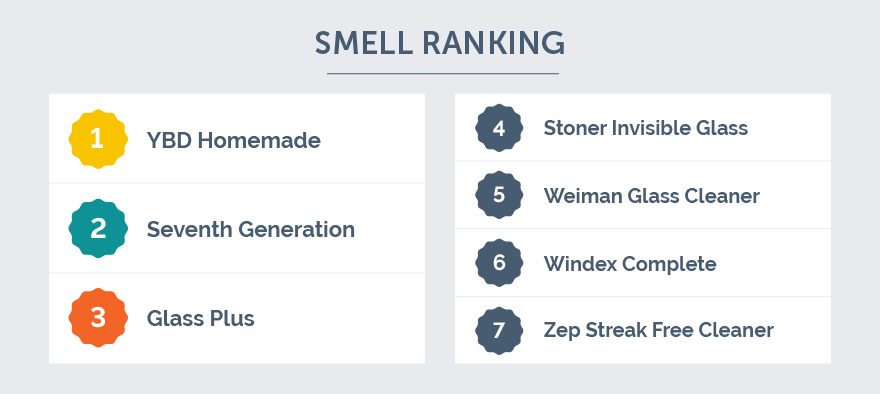
The aroma created by these cleaning products is not a small metric to consider. When cleaning windows and mirrors with airborne sprays, smell is an important and quickly noticeable factor.
Most of these cleaners do not smell good, falling somewhere between vaguely unpleasant (Stoner Invisible Glass) and extremely off-putting (Zep Streak-Free Cleaner). The two ammonia-based cleaners, Zep and Windex, left by far the worst smell. The powerful scent of ammonia produces an almost nostril-burning effect. While the scent doesn’t linger long, the experience of using the spray is poor because of it.
The most pleasing aroma came from our own mixture of vinegar, cornstarch, and essential oil. Just 10 drops of the highly concentrated peppermint essential oil in our 20-ounce spray bottle made all the difference in the user experience of the homemade cleaner.
The great thing about making your own cleaner is you can select your favorite fragrance. Essential oils come in dozens of scents, including rosemary, lavender, tea tree, and lemongrass.
Seventh Generation has a neutral scent that is hard to discern. It may not make you smile like the aroma of your favorite essential oil, but neither will it turn you off as many of the other products did.
When you need to use window cleaners
Window-cleaning products became popular because they don’t leave behind the streaks that soap and other common cleaners often leave. A window or mirror looks clean when the oils and dirt are removed to reveal a crystal-clear view or reflection. But when glass is obstructed by streaky residue, it can be an eyesore.
You don’t want glass surfaces to just look clean, you want them to be disinfected and completely free of germs. Each one of our top seven products have ingredients that specifically disinfect surfaces.
While ammonia alone may kill many germs, like salmonella and E. coli, it isn’t recognized as a disinfectant by the FDA. Even when combined with isopropyl alcohol — as in Windex — it is not an effective defense against staphylococcus and other dangerous bacteria.
Other chemicals commonly used in glass cleaners offer more protection against germs, but if used improperly, they can cause irritation to the skin and respiratory system. Vinegar is a great natural antibacterial disinfectant, but many find the smell offensive, and it sometimes fails to thoroughly clean tough jobs.
When you shouldn’t use glass/window cleaner
While window cleaners are great products for many jobs around the house, they need to be kept away from certain tasks. For the most part, window/glass cleaners are not intended for use on automobile surfaces and tinted glass because common ingredients will damage them.
Many manufacturers of glass cleaners offer separate products for automobile use, but Stoner does claim that their glass cleaner spray is safe for car surfaces.
Televisions and computer monitors shouldn’t be cleaned with glass-cleaning solutions. Unlike televisions from 20 years ago, modern TVs aren’t made of thick glass but of extremely thin layers of plastics, adhesives, display elements, and other materials.
When liquid penetrates these delicate layers, the monitors are ruined. A dry microfiber sheet should easily alleviate smudges, smears, and fingerprints from any modern monitor or display.
Another common mistake is using glass cleaner to scrub eyeglasses. Yes, “glass” may be in the name, but eyeglasses are covered with a coating that’s unique to the prescription and ensures proper vision. Soap and warm water are best.
The best way to clean windows
Professional window washers tend to use soapy water and a squeegee for commercial jobs. While this is an effective technique for large outdoor projects, it’s not a practical solution for most indoor home cleaning.
Inside smudges and fingerprints are caused by oily residue that must be cut by something other than water and soap alone. In addition, the squeegee technique can be messy: each stroke creates an excess of water that must be deposited somewhere and inevitably ends up on window sills and floors.
Particularly indoors, you want to use a fabric that collects the liquid that’s sprayed on the glass — but which fabric?
While paper towels are useful to keep around the house, we found through our research that they’re not ideal for cleaning glass. First, they are made with dyes and adhesives that actually bind sheets together to make rolls of two-ply. These substances will leave streaks of their own, separate from those left by any residual cleaning liquid. Paper towels also leave behind lint, and they’re not the best choice for the environment or your wallet.
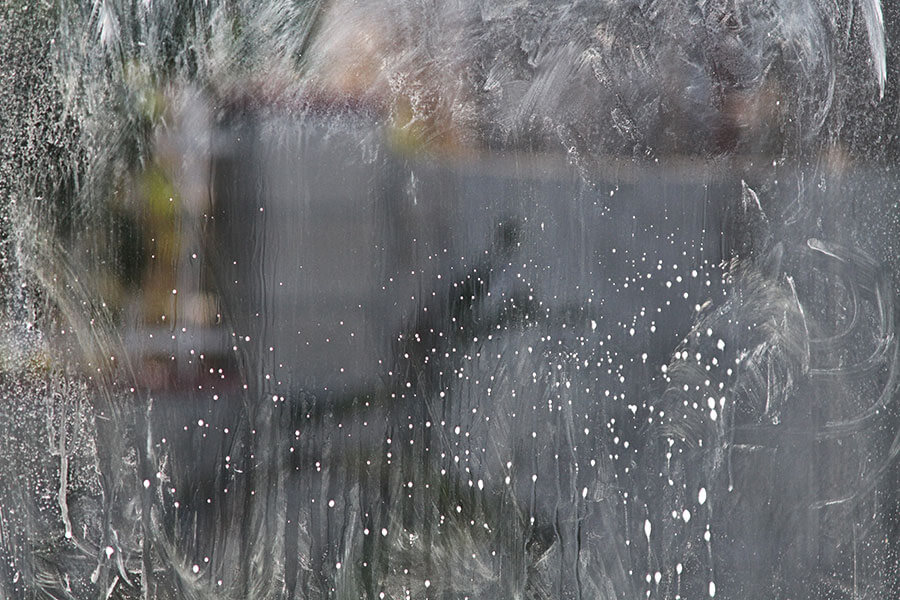
Many people swear by using newspaper to clean their windows. It does a great job of eliminating streaks, but it lacks real absorbency, which means going through lots of it or using a paper towel first and then buffing away the streaks and lint with a sheet of newspaper.
We found that microfiber towels were the easiest to use and the most reliable for cleaning dirt, absorbing liquid, and leaving no trace of streaks or residue. Microfiber towels are constructed with a synthetic blend of polyester and polyamide. The fibers are extremely small, measuring about ⅕ the diameter of human hair. This means they’re soft, durable, and absorbent — perfect for cleaning not just windows but almost anything.
Once we selected the proper tool, we started researching the method of cleaning. Interestingly, we learned that the weather can have a significant impact. We found that if you’re cleaning windows on a hot sunny day, you’ll end up with streaks — no matter what kind of material or product you use. The sun will dry the liquid on the glass before you’re able to wipe it clean, so it’s best to wait until dusk or a cloudy day.
Before we tested our products, we practiced several variations of wipe strokes, amount of liquid, and timing and application. The following steps are our recommendations for cleaning all glass surfaces.
How to clean glass
- Hold the nozzle six inches from the surface.
- Spray directly onto the glass.
- Spray evenly in horizontal rows, six inches apart. This should ensure that the circumference of the sprays overlaps on the glass.
- Using a microfiber towel, slowly swipe left to right once over each row, applying a gentle to slightly-moderate amount of pressure.
- The second time through, use a motion from the top of the glass to the bottom, applying a bit more pressure to absorb all the remaining liquid.
- Finally, use a fresh, clean, dry microfiber towel to vigorously buff out any imperfections left on the glass.
Other uses for window/glass cleaners
Glass cleaners are perfect for tackling dirty windows and mirrors, but they’re also capable of doing so much more.
We found that glass cleaners can be used to clean the following items:
- The surfaces of kitchen appliances
- Doorknobs
- Bathtubs
- Dry-erase boards
- Fabric
- Carpet
- Jewelry
Surfaces other than glass — like granite, marble, laminate, and tile — are safe to clean with most glass/window cleaners. The same ingredients designed to cut oily smudges on mirrors will also cut the greasy buildup on kitchen appliances, like blenders and coffee makers. Even stains on fabric and carpet can be broken up and easily removed by applying glass cleaner.
Another great task for glass cleaners is jewelry. Sterling silver and diamonds in particular can really be made to sparkle and shine with a just a small bit of the solution.
The most fascinating application of glass cleaner is combatting insects. A small bowl of the glass cleaner can be left out on the counter to deter them from a particular area. A small amount rubbed onto the skin can even relieve pain from a bee sting.
The DIY movement
The do-it-yourself, or DIY, movement has coincided with the rise of the internet in the last 20 years. The substantial amount of information available on DIY projects — from automotive repair to better housekeeping — is easily accessed through blogs, video tutorials and social media. Projects that were once thought of as challenging, or even impossible, are now easily demystified.
DIY solutions are appealing because they can be personalized, can utilize natural ingredients and can be cheaper than some commercial offerings.
How to make DIY window cleaner
Many glass cleaners rely on a solution of chemicals, including ammonia. While commercial glass-cleaning products are considered safe for regular home use, there are ways to avoid them.
The best way is to make your own glass cleaner using white vinegar, cornstarch, water, and essential oils.
While the end result may not be as streak-free as a window cleaned with Windex, using a homemade cleaner could be worthwhile for those who want to save some money and also want to use a product that only includes ingredients they are comfortable with.
We could have devoted an entire post to the topic of creating the best DIY window cleaner. Many people believe that simply mixing water with soap is sufficient, while others claim it’s not enough to avoid streaking. Some tout the advantages of rubbing alcohol, lemon juice and ammonia, but there are just as many who swear by vinegar alone.
We wanted to create an alternative that was all-natural, so we disregarded recipes that called for ammonia. We also avoided using dish-washing liquid or other manufactured soaps that relied on buying and watering down a store-bought cleaning solution.
We tried several combinations of the most popular ingredients with varying results. We decided to move forward with a slightly modified version of a recipe provided by Crunchy Betty, who performed similar tests using different natural ingredients and concluded that warm water, white vinegar, and cornstarch provided the best results.
Ingredients in the Crunchy Betty DIY Solution
Vinegar is by far the most recommended household cleaning alternative to a store-bought product. Vinegar is a weak form of acetic acid that is formed by the fermentation of sugars or starches. It cuts through grease and dirt and is a powerful disinfectant against common household bacteria. Vinegar can also help remove odors from the air and from surfaces.
Corn starch is an important ingredient because it eliminates streaking. Streaking happens because glass is not entirely smooth. The surface of glass contains microscopic pits and divots that collect water molecules, which bond to other water molecules as a cleaner is being wiped off.
This results in a streak of molecules fighting to bond with the water stuck in the tiny pits of the glass. Corn starch disrupts the ability of hydrogen atoms — found in both the glass cleaner and in water — to bond, thus making it easier to remove all the water from the glass.
Water is essential to combine, dissolve and deliver all of the ingredients onto the glass. We recommend using filtered or even distilled water to avoid dirt or contaminants leaving any visible residue on the glass’ surface. Warm water will help to diffuse dust and carry away impurities.
Finally, we wanted to add essential oil to our homemade glass cleaner. We love essential oils because they leave a clean, long-lasting smell. (Read our post on essential oil diffusers for more information.) We also discovered that, similar to cornstarch, essential oil helps combat streaking by preventing the bonding of hydrogen atoms in water molecules.
Those unable to invest the time in creating their own solution at home, but who also want a more natural product, can try Seventh Generation Free & Clear Glass & Surface Cleaner.
Important features to consider
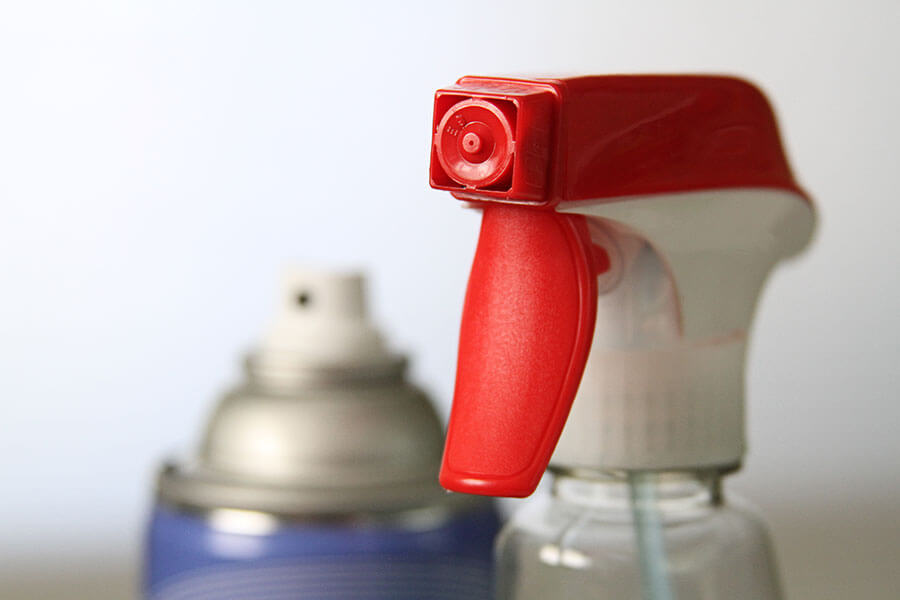
Ingredients
Manufacturers of window cleaner rely on a variety of chemicals and compounds to create their products. Learning just a bit about these substances will help you make an informed decision about their effectiveness and potential health impact. Because glass surfaces, like mirrors and windows, are cleaned frequently and touched regularly, it’s important to understand what exactly goes into their cleaning products.
A substantial amount of information is available about many of these ingredients. It can sometimes be complex, contradictory, alarmist and hard to interpret. For those who are interested, we encourage you to look into it for yourselves. What follows is an introductory discussion about some of the most featured ingredients in glass cleaners.
Ammonia
Ammonia is one of the most widely used chemicals in the United States. It’s mostly added to fertilizer and other agricultural products as well as cleaners, pesticides, plastics, and water purifiers. It is an active ingredient in both Windex and Zep Streak-Free Glass Cleaner. The other five products we tested are ammonia-free.
Ammonia is included in many household cleaners because it evaporates fast, preventing streaks — which our testing confirmed. Because it evaporates so fast, many argue that health risks are minimal. However, ammonia is extremely toxic, and overexposure can cause respiratory and skin irritation as well as asthmatic and allergic reactions. Contact with the eyes or accidental ingestion of products containing ammonia will require professional medical attention.
It should also be noted that not only is ammonia highly flammable, but it can also create a dangerous chemical reaction when combined with bleach. When bleach is mixed with ammonia, toxic gases called chloramines are produced. These chloramines can cause nausea, shortness of breath and fluid to accumulate in the lungs. Be sure to keep these two chemicals away from each other and away from children.
Glycol ethers
Glycol ethers are a group of solvents that are common in many cleaners, degreasers, and water-based paints. In addition to causing a sore throat when inhaled, glycol ethers can contribute to narcosis, pulmonary edema, and severe liver and kidney damage when inhaled in significant quantities, according to the EPA. Chemicals that fall under the glycol ether umbrella include 2-Butoxyethanol (an ingredient in Weiman Glass Cleaner and Zep Streak-Free Glass Cleaner), propylene glycol (an ingredient in Windex), and methyl ether (an ingredient in Glass Plus Glass Cleaner Trigger).
Glycol ethers attack dirt, grease, and soap scum by dissolving them and making them easier to remove. When cleaning with products containing these chemicals, proper ventilation is essential. Turn on fans, open windows, and go outside for fresh air at the first signs of discomfort or irritation.
Fragrances
Almost all the products we tested (with the exception of Seventh Generation Free & Clear Glass & Surface Cleaner and our DIY solution) contain some type of fragrance agent. In an effort to protect proprietary information, manufacturers do not break down exactly what creates these scents. Often, fragrances are made with phthalates, which have been linked to several adverse medical conditions, including damage to the liver, kidneys, and lungs.
Phthalates also cause a reaction in the endocrine system that leads to disruption and ultimately impacts reproductive health, particularly male sperm count. Again, because companies are not required to disclose the components of their fragrances, it’s impossible to determine which do and do not contain phthalates and in what concentrations.
Other ingredients
There are many other ingredients that go into creating our top six products. Some have raised more concerns than others. Manufacturers of these products are not required to list the ingredients on the bottle, and most don’t. While some companies provide a list of ingredients online, there is no guarantee that these lists are complete.
Recently there have been efforts at both the state and federal level to require disclosure of all ingredients in household chemicals directly on the packaging. Because information and transparency are essential to making fair comparisons and wise decisions, we encourage you to do some of your own research into these products and others that you use frequently around your home.
Regardless of which product you buy, there are several universal rules for increasing safety and limiting exposure to any potentially damaging chemicals.
Rules for Safe Cleaning
- Increase ventilation as much as possible. Open windows and turn on fans.
- Do not use glass cleaners on dishware, cooking utensils or children’s toys.
- Keep away from open flames and high heat.
- Store out of reach of children.
- Use as directed and contact a medical professional if you experience any alarming symptoms.
While all the products we tested are liquids, they are delivered by two different methods: spray bottle and aerosol can. The offerings from Stoner and Weiman are both aerosols, though neither contains CFSs, which have been proven to slowly deplete the ozone layer.
These cans are metallic, and their contents are under extreme pressure. Exposure to high heat or accidental puncture of the cans can be dangerous.
The advantage of aerosol is that it produces more of a foaming substance when it’s applied to a surface. These foams provide more complete coverage and saturation while also breaking down difficult-to-remove fats and sediment.
All of the other products, including the one we made ourselves, are applied with a spray bottle. Seventh Generation Free & Clear Glass & Surface Cleaner comes in a bottle with a childproof mechanism that makes it very difficult to remove the nozzle. Even though Seventh Generation has the least objectionable ingredients, this is a nice feature to guard against accidental ingestion by children.
The bottom line
The best product for getting reliably clean and clear glass is Windex. It can be used on a variety of surfaces to clean without leaving streaks, and it’s strong enough to get rid of tough stains.
Whichever cleaner you choose, how you clean is just as important. We recommend microfiber towels for both wiping up messes and buffing out streaks. We also encourage you to keep these and all cleaning products away from children and increase ventilation as much as possible while cleaning by opening windows and turning on fans.
More Reviews
The 9 Best Mops For Hardwood Floors
Rubbermaid - Reveal Spray Mop
DELOMO - Pet Hair Roller
SimpleHuman
The 8 Best Vacuums for Hardwood Floors
Shark - Apex
Shark - Rocket HV302
Shark - Apex
Iron Out - Stain Remover
Tide - Coldwater Clean


